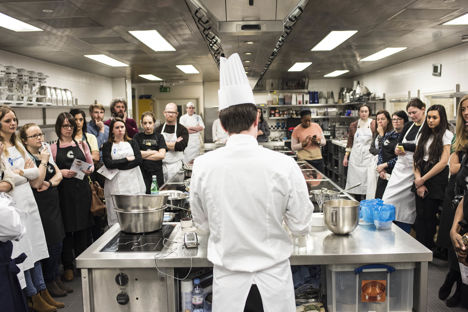
Cook school confidential: cooking with coffee
We invited Michelin-starred Italian chef Roberto Petza over to Le Cordon Bleu as part of our Great Italian Chefs cookery school series. Discover how he uses coffee in cooking and why it's one of his favourite ingredients.
Cook school confidential: cooking with coffee
We invited Michelin-starred Italian chef Roberto Petza over to Le Cordon Bleu as part of our Great Italian Chefs cookery school series. Discover how he uses coffee in cooking and why it's one of his favourite ingredients.
As the head chef of Sardinia’s Michelin-starred S’Apposentu, it’s clear that Roberto Petza knows how to cook. But he’s also incredibly passionate about coffee, which is why in 2014 he won a Lavazza Prime Award – an accolade given to chefs who take as much care over the end of meal espresso as the food itself. For this reason, he was chosen to host a Great Italian Chefs masterclass, in association with Lavazza, at the prestigious Le Cordon Bleu cookery school in London.
Treating coffee as an ingredient is becoming more and more common in both professional and home kitchens. The recipes no longer focus on creamy desserts, either – tiramisu is always going to be a popular classic, but coffee is now used in a savoury context. Italians are world famous for their coffee, so it makes sense that many of these recipes are being conceived in the country.
Here are five ways coffee is being used as an ingredient in cooking, with tips from Roberto, things we learnt at Le Cordon Bleu and some coffee recipes from other top chefs.
Dressed to impress
The main dish Roberto wanted to show everyone at the cookery school was a seasonal Jerusalem artichoke, celery and fennel salad flavoured with a coffee-spiked dressing. Spiced lemon-infused coffee is something that’s enjoyed all over Italy throughout the summer, and Roberto drew inspiration from the drink to add intensity to the vinaigrette served alongside. The floral and wild cherry notes in the coffee worked particularly well with the hints of aniseed from the celery and fennel in the salad, putting a modern, interesting twist on the classic Italian dish.
Something sweet
While using coffee in a savoury context tends to be what grabs the headlines, it’s still a great way to add depth of flavour to sweet dishes. Roberto challenged Le Cordon Bleu's Master pastry chef Nicolas Houchet to create a light dish that displayed the sweet honey and date notes in a particular type of coffee. What Nicolas ended up with was a fluffy, iced coffee soufflé, which would tick both the dessert and digestif boxes at a dinner party.
As a marinade
Coffee comes in many forms – whole beans, ground to a powder and brewed as a liquid – which makes it a pretty versatile ingredient. In its liquid state, coffee can be used as a very effective marinade, as its acidic nature means it will tenderise meat as well as adding a depth of flavour. It can also work well as a spice rub; Roberto marinates veal ribs for twenty-four hours in a mixture of ground up coffee beans, herbs, spices, garlic and salt, before slow cooking it in olive oil.
Shake it up
The espresso martini is one of the success stories of the modern cocktail scene (conceived by the late Dick Bradsell, one of London’s most famous bartenders in the 1980s) and is now a staple on cocktails lists across the world. This simple drink opened the gateway to more inventive coffee-based tipples, whether the beans are used as a simple garnish (something Vivek Singh incorporates into his Oaxaca coffee cocktail) or playing a more prominent role (like this Moka martini served at Pied à Terre).
The miracle cure
Ground coffee can also be used as a seasoning, something which the Costardi Brothers are huge fans of, adding a sprinkle to their cuttlefish dish for a bitter finish that contrasts perfectly with the creamy seafood and potatoes. But one of the most interesting ways ground coffee can be used is as a cure. When mixed with salt and other flavourings, coffee can really help flavour meats as they dry out. One of the best examples of this is Luke Holder’s coffee-cured foie gras, which he serves alongside pigeon, cherries and spiced bread.


